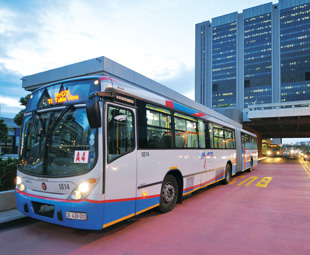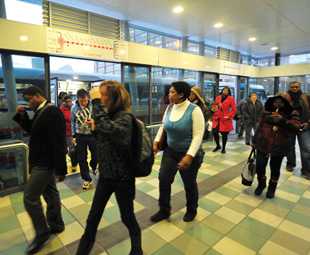Mother City boards the BRT

In 2009, the City of Cape Town tabled a business plan to implement Integrated Rapid Transit (IRT) and Bus Rapid Transit (BRT) to facilitate more efficient commuter movement. FOCUS takes a look at how the fledgling stage of BRT is faring.
Bus Rapid Transit (BRT) forms an integral part of Integrated Rapid Transit (IRT) systems in several big cities in Europe, Latin America and in Johannesburg.
According to the City of Cape Town’s IRT Business Plan: “Public transport is a key mechanism for achieving the City’s transport vision of providing a sustainable transport system that moves all its people and goods effectively, efficiently and safely without compromising people, the economy or the environment. Provision of a quality public transport service is essential to create a substantial shift from private to public transportation, thus increasing public transport market share, revenue generation, urban efficiency and improving air quality. Effective and efficient public transport is critical to the social and economic development of urban areas and the country as a whole.”
The Business Plan also pinpoints the historical challenges facing its commuters and citizens at large: “Currently, public transport is often unsafe and inconvenient to both citizens and visitors. In Cape Town, as in other cities in South Africa, public transport is widely regarded as inadequate. Subsidised bus and rail systems have relatively low fares, but peak services are uncomfortable and off-peak services are inconvenient, where they exist at all.
Outlining the benefits of BRT within an IRT strategy, the Business Plan states that: “BRT is a highly effective urban public transport mode. One of its key strengths is its flexibility, both in serving varying passenger demand levels as well as penetrating the existing urban fabric. By combining different vehicle sizes and frequencies it can meet a wide range of demand levels conveniently and cost effectively. With its network of trunk and feeder routes it can penetrate the urban fabric at a much finer level than, for example, rail. And unlike rail, which tends to divide urban space, BRT allows greater ease of movement across transport routes, facilitating growth along corridors. BRT also supports the shift from private to public transport by providing a high quality of service.”
 Branded ‘MyCiTi’, Cape Town’s BRT system includes a number of features that promise a world-class commuter travel experience: dedicated bus-ways, enclosed trunk stations, level boarding platforms and high-quality fittings, short waiting times between buses, modern information and communications technology, centralised vehicle control and fare management, enhanced passenger security, as well as the competitive accommodation of existing minibus-taxi and scheduled bus operators within the new system.
Branded ‘MyCiTi’, Cape Town’s BRT system includes a number of features that promise a world-class commuter travel experience: dedicated bus-ways, enclosed trunk stations, level boarding platforms and high-quality fittings, short waiting times between buses, modern information and communications technology, centralised vehicle control and fare management, enhanced passenger security, as well as the competitive accommodation of existing minibus-taxi and scheduled bus operators within the new system.
In an interview with Kylie Hatton, City of Cape Town media spokesperson, FOCUS asks about the progress of MyCiTi, which was officially launched during May.
When does the City of Cape Town foresee completion of Phase 1 of BRT and what areas/routes will it service?
Kylie Hatton: Phase 1 is anticipated to be completed by the end of 2013. The areas covered by the MyCiTi services in Phase 1 include the inner city area from Hout Bay to the CBD and Salt River along the Atlantic Seaboard, and the West Coast corridor from the CBD to Atlantis, including Mamre to the north and Dunoon, Century City and Montague Gardens to the east.
Who owns the BRT buses?
KH: The City of Cape Town bought the buses from Volvo who won the bid for that specific tender in December 2009. Currently 42 buses are running the Airport service, the Gardens-Civic-Waterfront feeder route, and the Table View trunk and three feeder routes.
What models of Volvo buses are currently deployed in the MyCiTi service?
KH: These are the Volvo B7R MK3 commuter bus and the Volvo B12MA articulated commuter bus. They are both low-emission Euro 3 compliant, extremely comfortable and quiet and have proven themselves in BRT applications in other cities around the world.
How many routes are currently being serviced and between which points in the metropol do they travel?
KH: At the moment there are six routes in operation.
How many kilometres do the in-service buses travel per day?
KH: About 9 500 km per day across the fleet (including out-of-service travel to the depot)
How many passengers currently use the BRT service?
KH: Unfortunately, with the paper ticketing system it is a little difficult to determine an exact number right now; however, estimates are between 2 500 and 3 000 passengers per day, taking into account all the feeder routes, the trunk and the Airport route.
How are drivers recruited?
KH: The vehicle operating companies that are made up of mini-bus taxi associations and bus companies supplied the drivers, many of whom were previously working in the minibus taxi or bus industry.
What are the driver selection criteria?
KH: The vehicle operating companies select the drivers, so they are the ones stipulating the criteria in terms of specifications for public transport operators. There are currently three contracted public transport operators servicing MyCiTi: Golden Arrow Bus Services, Transpeninsula and Kidrogen.
How is the taxi industry responding to the BRT rollout?
KH: The directly affected taxi associations have engaged very well and the minibus taxi operators in the Table View and CBD area are now working on the MyCiTi buses on the route. The company Kidrogen is comprised of several taxi associations.
When MyCiTi reaches full service levels, what benefits will it bring to the city?
KH: This integrated system will make it possible for all citizens to access a network of predetermined routes across the entire city, making it an affordable, convenient and more ecologically friendly way to travel anywhere in the city. Once the final phase of the project has been completed, the idea is that all Capetonians will have a stop within easy walking distance of their residence. This will also help alleviate congestion on the roads and parking within the CBD. And, our air will be cleaner.
For non-Capetonians, MyCiTi will be a blessing when visiting the Mother City. Not only will the visitors be spared the dreaded CT traffic jams, they will no longer have to ask for directions. Well done ‘CiTi’ of Cape Town!
Published by
Focus on Transport
focusmagsa



